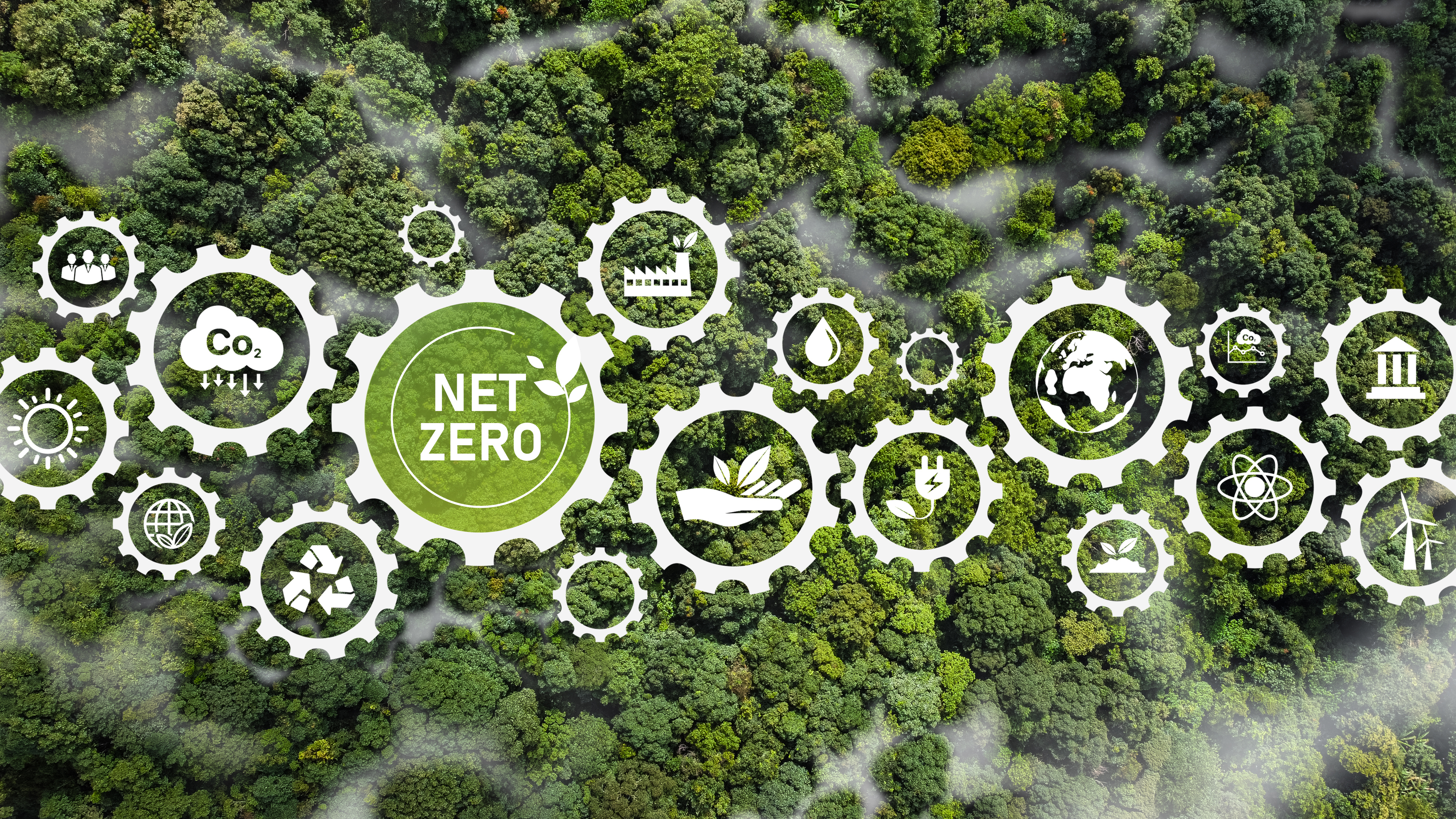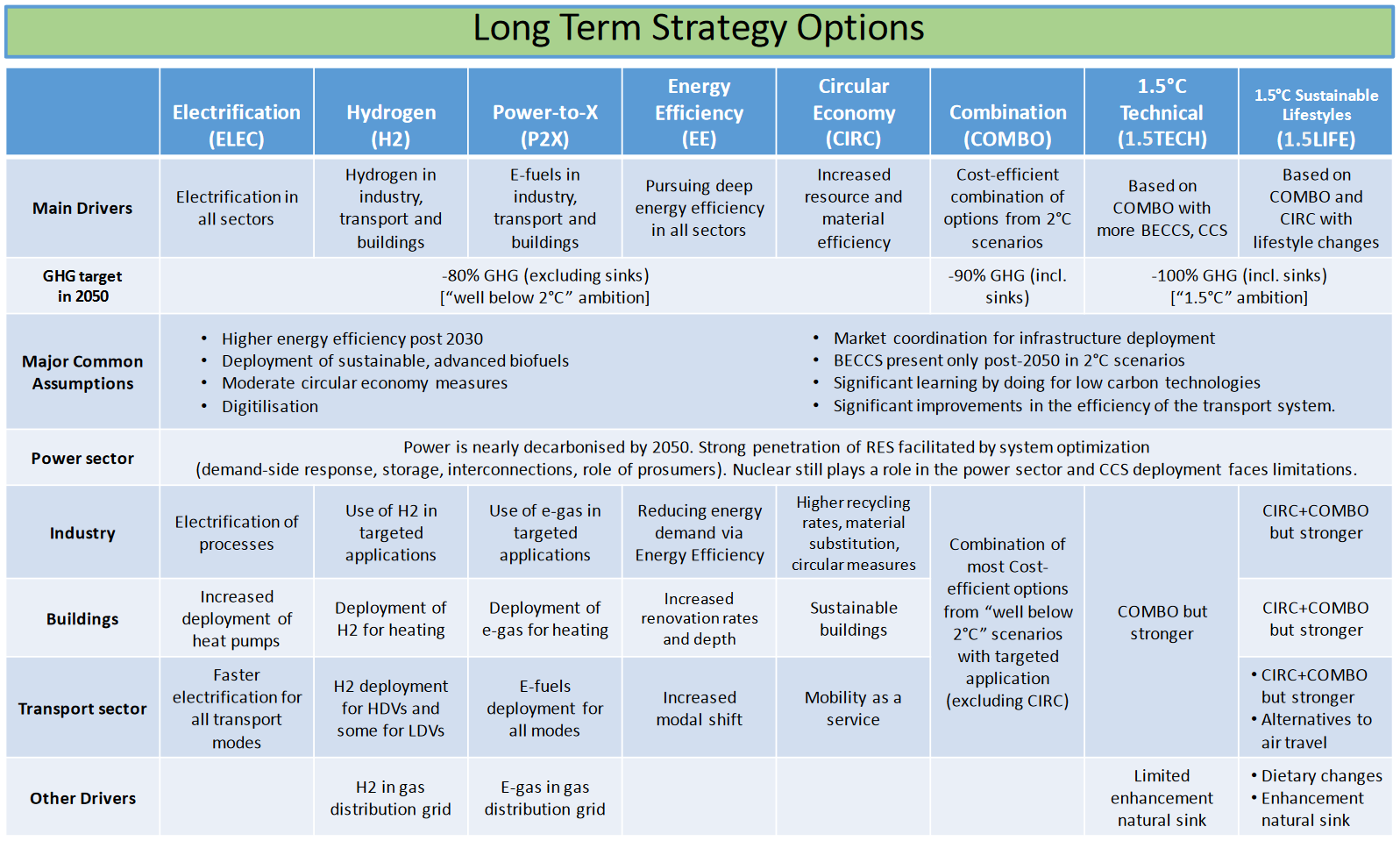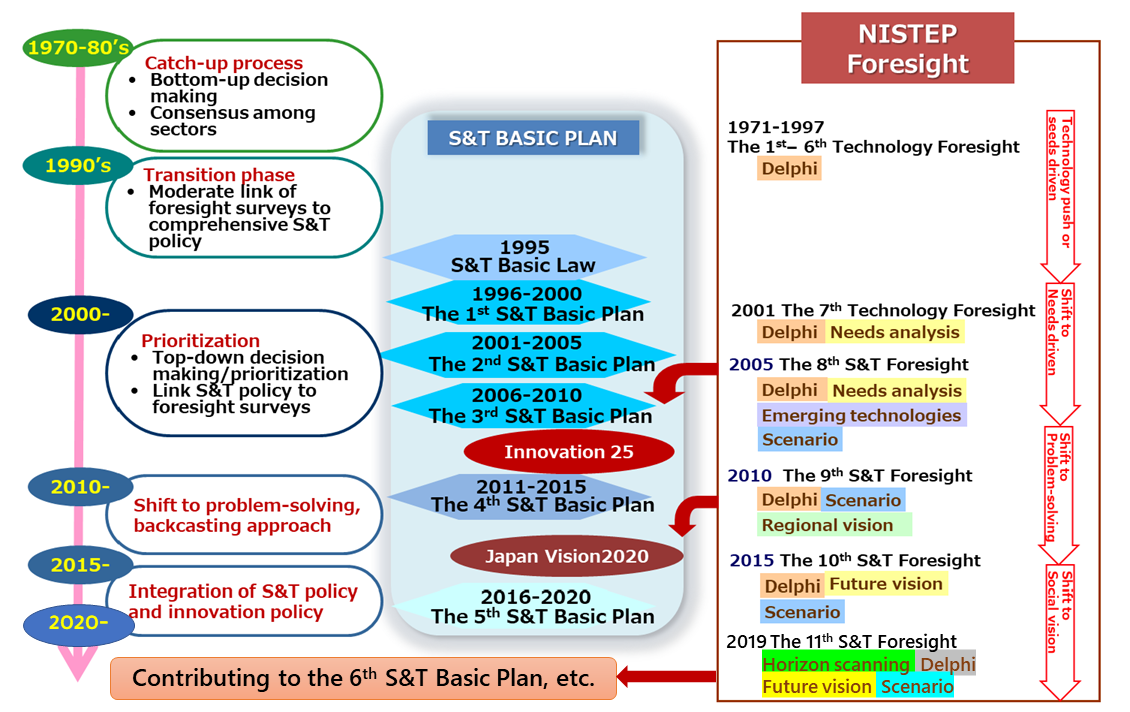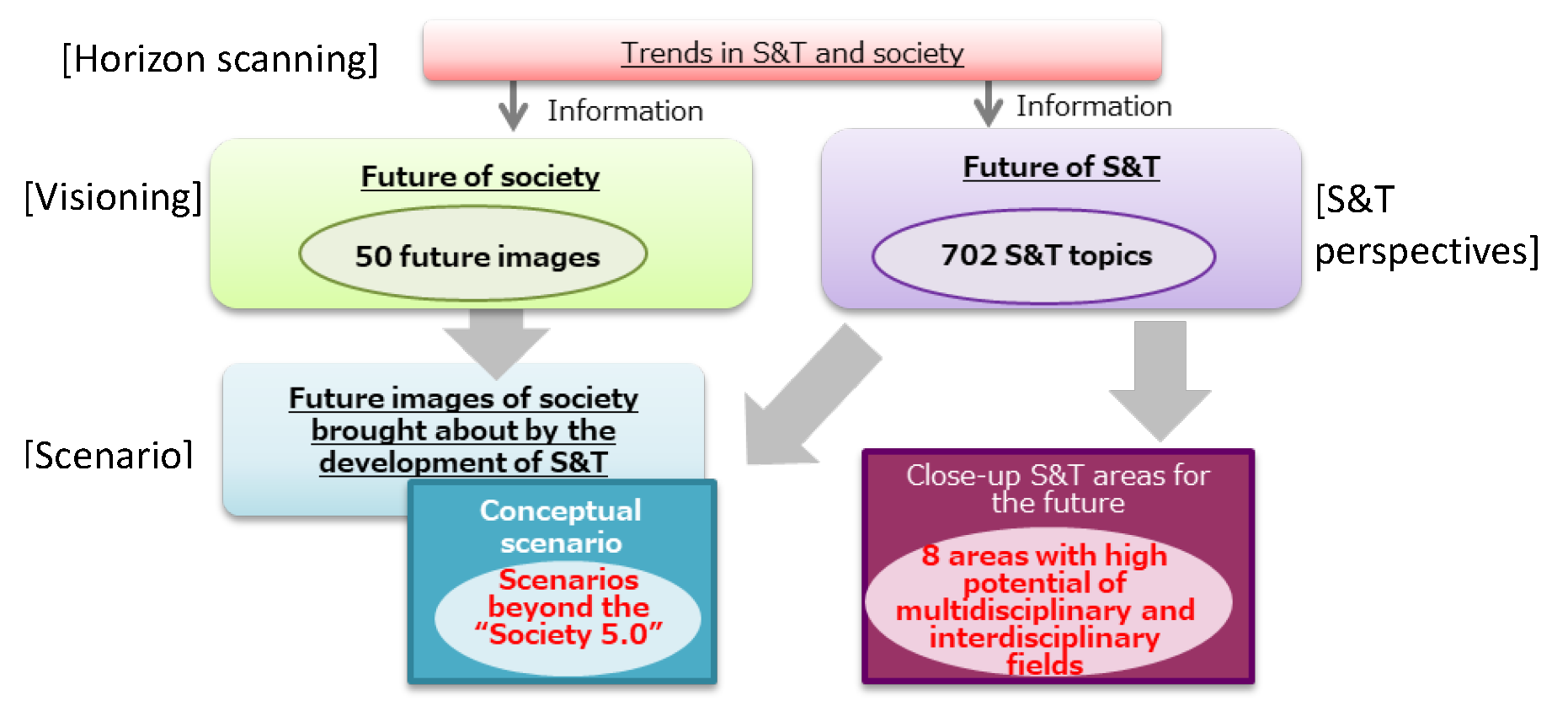
Future of S&T developments contributing to Carbon neutrality: From the 11th Science and Technology Foresight Survey
March 27, 2023
C-2022-001-4WE
In an article translated from the Foundation’s CSR White Paper 2022, S&T policy expert Kuniko Urashima describes the findings of the latest national survey on emerging technologies and shares ideas on ways to achieve Japan’s carbon-neutral targets.
* * *
Japan has joined many other countries in announcing a 2050 goal of net zero greenhouse gas emissions and carbon neutrality. What this will require is for the electric power sector to expand the use of non-fossil sources and for decarbonization to be promoted (in the use of fuel and heat) in the industrial, residential-commercial, and transportation sectors through such means as electrification, hydrogenation, methanation, and development of synthetic fuels. Efforts will be needed by not just large companies but also individuals—a point that will have to be emphasized in regions with high CO2 emissions and high reduction potential. Initiatives toward the goal of achieving carbon neutrality and building a decarbonized society can bring additional benefits as well, such as by promoting innovation and economic growth, especially in communities beset by dwindling and aging populations.[1]
The following offers a glimpse into the kind of technologies and developments that could help significantly reduce CO2 levels and realize a decarbonized society, based on the results of science and technology surveys conducted over many years by the research institute with which the author is affiliated.
Momentum toward Carbon Neutrality
The questionnaire survey on carbon neutrality, conducted by the Tokyo Foundation for Policy Research for the 2022 white paper on CSR, found that more than 70% of responding companies are either implementing or planning carbon-neutral initiatives. The most popular factor cited for taking such action, at 61%, was Japan’s aforementioned 2050 goal, announced in October 2020 by then Prime Minister Yoshihide Suga. Asked in a multiple-response format about the motives for their decision, 86% said they wished to resolve a societal challenge, and 78% hoped to improve their corporate image. As for factors hindering action, many pointed to a lack of human resources. Efforts toward carbon neutrality are most often spearheaded by management (35%), although companies also rely on private consultants for strategy formulation. Corporate offices have largely switched to energy saving equipment and other environmental-friendly products, but subsidies are needed to offset the high cost of renewable energy. A surprisingly high share (69%) said they are not familiar with domestic initiatives to revitalize local communities, combat global warming, and achieve in-house carbon neutrality. These results suggest the need to make fuller use of existing technologies and subsidies and to more broadly share successful case studies.
In November 2018, the European Commission issued “A Clean Planet for All,” a long-term strategic vision for a “climate neutral economy” in 2050. While presenting various reduction pathways, it notes that they must be interpreted with caution due to “long run uncertainties around the success of technologies,” given that “technological progress, consumer choices and regulation can lead to different results.” It also presents eight emissions reduction scenarios, as shown in Figure 1. They are grouped into three categories. The first, consisting of the five scenarios on the left, addresses the well below 2°C ambition, aiming for GHG emissions reduction levels in 2050 of around 80% compared to 1990. The second is the “combination” of the actions and technologies of the five scenarios in the first category, resulting in net reductions of close to 90%. And the third—the two scenarios at the right—achieves even bigger reductions, reaching net-zero GHG emissions by 2050 and thus pursues efforts to limit temperature change to 1.5°C. That many countries identify carbon neutrality as a policy priority represents a major business opportunity for Japanese companies possessing relevant technologies.
Figure 1. The EU’s Eight Scenarios toward Carbon Neutrality
Source: European Commission, “A Clean Planet for All: A European Long-Term Strategic Vision for a Prosperous, Modern, Competitive and Climate Neutral Economy,” https://climatecooperation.cn/wp-content/uploads/2019/06/com_2018_733_analysis_in_support_en_0.pdf.
Anticipated S&T Developments
The National Institute of Science and Technology Policy (NISTEP) is a national research institute engaged in the Japanese government’s science and technology policy planning process. Every five years since 1971, NISTEP has conducted a large-scale survey of anticipated science and technology developments called Science and Technology Foresight. The findings are compiled into reports by NISTEP’s Science and Technology Foresight Center. The S&T Foresight has been issued 11 times thus far, as shown in Figure 2, with each study incorporating the methods most appropriate to the needs of society and policymakers at the time. The first seven Foresights were centered on technology, but since the eighth survey, we have sought to provide basic information that would aid the government’s formulation of its Science, Technology, and Innovation Basic Plan.[2]
In recent years, as the survey expanded its scope to cover the application aspects of science and technology, we have sought to add a qualitative dimension to our study, augmenting the quantitative results obtained through the Delphi method[3] with development scenarios provided by experts and analyses of academic papers. This has resulted in a bird’s-eye view of science and technology, providing insights into the development potential of the basic sciences and the social and economic needs that science and technology must keep in mind. Any longer-term outlook covering a span of 30 years requires input not just from scientists and engineers in academia and industry but also from experts in the humanities and social sciences; the needs of users must also be considered. The results of all 11 studies conducted to date can be viewed on the NISTEP website.[4]
Figure 2. NISTEP Foresight Studies to Date and Relevant Policy Developments
Source: NISTEP website.
Figure 3. The Four Components of the 11th S&T Foresight
Source: NISTEP website.
Figure 3 outlines the four components of the 11th S&T Foresight,[5] each having its own objectives and target years.
The first component is Horizon Scanning,[6] undertaken with a software tool developed by NISTEP called KIDSASHI (Knowledge Integration through Detecting Signals by Assessing/Scanning the Horizon for Innovation). KIDSASHI automatically crawls the websites of approximately 300 organizations (major public and private universities and corporations) once a day for research-related news. The information is analyzed both quantitatively and qualitatively using AI technology to extract insights into future outlooks and signs of change, thus enabling the visualization of overall S&T trends and the discovery of weak signals.
The second component is Visioning, consisting primarily of a workshop on the desirable society of the future, attended by around 100 stakeholders: experts in the humanities, social sciences, and natural sciences and researchers—both junior and senior—from industry, academia, and government. I will skip over the details of the workshop here.
Forecasting the Future of Technology
The third component is S&T Perspectives, a Delphi survey that gathers collective forecasts for the future of technology. Looking 20 to 30 years ahead, it estimates when particular technologies are likely to come online and identifies measures to expedite their realization. With a history of over half a century, the survey can reasonably assess the realization prospects of various technologies. Such surveys have the longest history in Japan and are highly valued in other countries for their focus on technology. The results—starting from the 1st Technology Foresight—are available as a database on the NISTEP website.[7]
The 11th survey, conducted in 2019, set 2040 as the target year but also looked 30 years into the future to 2050. To gain a bird’s-eye view, the survey covered 702 science and technology topics expected to be realized by 2050 in seven fields, namely, (1) health, medicine, and life sciences; (2) agriculture, forestry, fisheries, food, and biotechnology; (3) environment, resources, and energy; (4) ICT, analytics, and service science; (5) materials, devices, and processes; (6) cities, architecture, civil engineering, and transportation; and (7) space, ocean, earth, and science foundation. In response to a questionnaire, 5,352 experts in the seven fields submitted responses on each topic in terms of importance, international competitiveness, expected year of realization, and policy measures for their realization.[8]
Figure 4. Keywords and Future Prospects in the Field of Environment, Resources, and Energy
|
Subfield |
Keywords |
Future Prospects |
|
Energy conversion |
Energy production, energy consumption, energy transport, CO2 capture and mitigation, hydrocarbon synthesis, renewable energy, sensing and monitoring, heat pumps and thermal conversion, development of laws and economic efficiency |
Short-term: Improvements in thermal efficiency of vehicles and secondary batteries Medium to long term (2050): Mitigating climate change and global warming with renewable energy and other technologies to build a sustainable society Other key areas include disaster prevention and resilience, which are not readily visible to energy consumers and general users |
|
Energy systems |
Renewable energy, surplus power utilization, power transmission, power storage, long-distance shipments of hydrogen and other resources, large-scale hydrogen storage, power trading, control of power supply and demand, unused heat |
In terms of importance and competitiveness, secondary batteries for electric vehicles and grid stabilization, as well as hydrogen production using surplus power from solar and wind power generation |
|
Resource development and 3Rs (reduce, reuse, recycle) |
Metal and nonmetal resources, petroleum resources, geothermal resources, environment, sharing and servicing, labor saving and automation, resource efficiency, using waste as energy, recycling, circular economy |
Important topics include specific measures for advanced recycling of resources for both material and energy use, innovative dismantling technology that maintains function to promote reuse, technology for dramatically improving the efficiency of the supply chain for resource circulation using information technology, and promotion of servicing through the sharing economy |
|
Water |
Groundwater map, continuous monitoring, torrential rainfall, water management technology, sewage treatment technology, water purification technology, technology to treat and recycle contaminated water, water quality indicator, microplastic in the hydrosphere, environmental science technology |
Important and competitive topics that have gained international recognition include integrated water management technology in densely populated areas, technology to treat and recycle contaminated water that can be used in developing countries, and continuous monitoring technology for water supply; there are strong expectations for domestic and international collaboration |
|
Global warming |
Greenhouse gases, fossil fuels, climate change, extreme weather events, future projections, atmosphere, oceans, ecosystems, ice sheets, water, food |
Data infrastructure must be developed to spur data distribution and processing, given the massive volume of resulting from higher resolution models and growing number of experiments; open data infrastructure should also be promoted to facilitate international sharing of observation data |
|
Environment conservation (analysis, prediction, evaluation, restoration, regeneration, plan) |
Soil restoration technology, decontamination technology, pathogenic microorganism detection system, migration and diffusion of invasive alien species, transboundary air pollution, genetic diversity, environmental load management, biodiversity, vegetation maintenance management |
Keys include human resources development, expanding R&D funding, international collaboration, and addressing ethical, legal, and social issues (ELSI); reinforcing R&D infrastructure will be particularly important in handling big data and advancing monitoring systems, and attention to ELSI concerns will be crucial to saving endangered species |
|
Risk management |
Biodiversity, environmental risks, resilience, safety standards, nanoparticles, chemicals, radiation, natural disasters |
There is a high need for human resources and improved laws and regulations to achieve consensus on various risks; domestic collaboration and cooperation are especially important in promoting distributed power utilization and control technologies in the wake of natural disasters |
Source: NISTEP website.
Figure 4 lists the key issues and developments identified in the survey for the various subfields of “environment, resources, and energy”—an area with a significant bearing on carbon neutrality. The field covers a broad range of important technologies, from those global in scale to more targeted issues like resource development, energy utilization, and recycling. Promoting technological development requires sweeping reforms of how existing systems are utilized. Risk management will also be a crucial factor given the growing need to win social acceptance of new technologies.
Survey respondents were asked to rate the importance and international competitiveness of various emerging technologies on a 5-point scale and to forecast when those technologies were likely to be realized and used in society. Figure 5 shows the results for hydrogen-related technologies that can be expected to contribute to carbon neutrality, while Figure 6 outlines technologies relating to renewable energy and energy storage.
Figure 5. Importance, Competitiveness, and Realization Forecasts of Hydrogen Technologies
|
Topic |
Importance Score |
Competitive- |
Tech-nology achieved |
Used in society |
|
Reasonable technology for contactless charging infrastructure technology that sequentially charges cars when parked in public parking lots or when stopped at intersections, and technology for storing and supplying hydrogen with improved safety |
0.91 |
0.66 |
2028 |
2031 |
|
Hydrogen production using surplus power from solar and wind power generation |
1.18 |
0.68 |
2028 |
2031 |
|
Hydrogen production technology using renewable energy such as solar heat and others |
0.90 |
0.37 |
2028 |
2033 |
|
1 GW-class large-scale power generation technology by 100% hydrogen fuel gas turbine |
0.66 |
0.54 |
2030 |
2033 |
|
A high-density hydrogen carrier with a hydrogen storage density of 100 kg/m3 or more and a mass storage density of 10 wt.%, for fuel cell vehicles |
1.05 |
0.71 |
2031 |
2034 |
|
Aiming for a hydrogen society, a fuel cell where the amount of precious metal used is one tenth or less of that used in 2018, with consideration of catalyst deterioration |
1.18 |
0.94 |
2032 |
2033 |
|
Long-term hydrogen storage technology enabling economical and large-scale stable supply |
1.07 |
0.70 |
2032 |
2035 |
|
Membrane separation technology for producing hydrogen using coal as the raw material, without releasing CO2 into the environment |
0.82 |
0.47 |
2032 |
2036 |
Note: Scores for importance and competitiveness are calculated as very high (+2), high (+1), neither (0), low (-1), and very low (-2).
Source: NISTEP website.
Figure 6. Results for Topics Relating to Renewable Energy and Energy Storage
|
Field |
Topic |
Importance Score |
Competitive- |
Tech-nology achieved |
Used in society |
|
Materials |
High-capacity, high-power battery with an energy density of 1 kWh/kg or more and a power density of 1 kW/kg or more (for automotive, this would equate to a driving range of 500 km with the current size and weight battery) |
1.50 |
0.91 |
2030 |
2032 |
|
Environment |
Long-life and low-cost secondary batteries that do not require replacement for electric cars (life: 15 years, cost: ≤JPY5000/kWh) |
1.48 |
0.98 |
2029 |
2032 |
|
Environment |
Long-life and low-cost MW-scale secondary battery to stabilize grid connections (life: 20+ years, cost: ≤JPY 15,000/kWh) |
1.32 |
0.70 |
2030 |
2033 |
|
Materials |
Solar cell with conversion efficiency exceeding 50% |
1.31 |
0.71 |
2033 |
2036 |
|
Agriculture |
High-efficiency, low-cost power generation, thermal utilization technology using biomass such as wood |
0.94 |
0.31 |
2028 |
2030 |
|
Environment |
50 MW-class offshore floating wind power generation |
0.77 |
−0.05 |
2028 |
2032 |
|
Materials |
A new material for vibration-generated power with a storable output scale capable of efficiently converting friction/ mechanical stress to electric energy |
0.72 |
0.44 |
2030 |
2033 |
|
Environment |
An output of 10 MW-class or more power generation technology using marine energy resources such as waves, tides, tidal currents, and ocean temperature differences |
0.67 |
0.15 |
2030 |
2034 |
|
Materials |
Power generation system using high-rise westerlies and tidal currents with minimal environmental impact |
0.52 |
0.12 |
2033 |
2034 |
|
Environment |
Superconducting magnetic energy storage system for improving power stability on a scale of several tens of kWh |
0.49 |
0.55 |
2032 |
2037 |
|
Environment |
5 MW-class superconducting flywheel for power storage |
0.41 |
0.38 |
2031 |
2035 |
Source: NISTEP website.
Regarding the policy measures required for scientific and technological realization, respondents were asked in a multiple-response format to choose from among the following options: “human resources development (HRD),” “enlarged R&D funding,” “improvement of research platform,” “domestic collaboration/cooperation,” “international collaboration/standardization,” “improvement of legal regulations,” “addressing ethical, legal, social issues (ELSI),” and “other.” The top response was “enlarged R&D funding.” From a similar list of the factors needed for social realization, the highest share of respondents, 55%–65%, chose “improvement of business environment,” with significant shares also citing “improvement of legal regulations.” Items that were selected less frequently than average included “human resources development” and “addressing ethical, legal, social issues.”
Direction of New Developments
The fourth component of the survey was Scenario Planning. An attempt was made to explore the direction of new developments from a science and technology perspective by identifying—without being constrained by disciplinary boundaries—which of the 702 topics covered in the Delphi survey should be promoted in the future. Using machine learning and natural language processing technology, the 702 topics were mechanically classified into 32 clusters based on similarity. Experts then closely examined of the content of each cluster and integrated proximate clusters. This was the first time that AI-based processing and human judgment were combined in the Foresight study, yielding eight areas with high potential for cross-disciplinary integration, as shown in Figure 7.
Figure 7. Eight Areas with High Potential for Cross-Disciplinary Integration
|
No. |
Name |
Summary |
|
1 |
Science and technology towards social and economic growth and change |
Science and technology areas that understand and control more diversified and complicated social phenomena (Large Social Complex Systems) by modeling and simulating them by making full use of information processing technology and mathematical science. |
|
2 |
Next-generation biomonitoring and bioengineering for precision medicine |
A science and technology area consisting of biomonitoring that comprehensively understands various interactions in the human body, aiming at precision medicine that considers individual differences in genes, environment, and lifestyle, and also bioengineering that develops medical technology based on the results. |
|
3 |
Atomic and molecular level analysis technology using advanced measurement technology and information science tools |
Science and technology that integrate advanced measurement that enables the observation and survey of previously unseen objects, and information science, such as simulation, informatics, and AI, to lead to scientific clarification and the development of technologies in a wide range of practical fields, including drug discovery, catalysts, materials, and crops. |
|
4 |
Creation of novel materials and manufacturing systems |
A scientific and technological area consisting of elemental technologies that form the basis of manufacturing that is expected to bring about new value creation through advanced manufacturing and distribution systems enabling mass customization and meeting the diverse needs of individuals and global society in the future, such as solving social issues related to the Earth and the environment and improving humanity’s QoL. |
|
5 |
Advanced electronic and quantum devices that revolutionize ICT |
A scientific and technological area consisting of the human-machine interface and sensing in the IoT, which are the basis of deepening and fusion of human-machine relationships. Electronic devices with new materials and functions such as high-efficiency and high-speed devices that support advanced ICT systems with less environmental impact. Furthermore, science and technology fields related to quantum devices that have enormous information processing capabilities and are expected to be able to non-invasively measure and sense living organisms with high accuracy. |
|
6 |
Monitoring, evaluation and prediction technology of global environment and resources by space utilization |
By observing the Earth extensively from space and on the ground, it is possible to deepen our understanding of the Earth’s environment and resources, and improve our ability to predict changes that will lead to the exploration and management of energy and resources, and crisis management against natural disasters. |
|
7 |
Science and technology for promoting circular economy |
Science and technology areas related to diverse technologies and systems such as renewable energy, waste reduction and recycling, and sharing to promote the “Circular Economy,” a new economic model achieving economic growth by recovering, regenerating, and reusing consumed resources continuously. |
|
8 |
Advanced observation and prediction technology related to natural disasters |
A science and technology area for avoiding disaster damage so that no one is left behind, involving basic research to investigate the causes of natural disasters such as earthquakes, volcanic eruptions, and heavy rains that have occurred frequently in Japan in recent years, including technology for predicting the occurrence of these disasters, and science and technology related to national land conservation and design. |
Source: NISTEP website.
While the findings of each of the four components can be used separately in accordance with specific needs, they should preferably be taken as a whole, as they constitute one of the few examples of quantitative and qualitative data on the future impact of science and technology.
Conclusion
The above was an attempt to summarize those sections of NISTEP’s S&T Foresight that offer insights into carbon-neutrality pathways. Many companies have already been working for years to reduce their CO2 emissions, so exhorting them to do more of the same will likely produce few breakthroughs; instead, unconventional, out-of-the-box approaches may prove to be more effective. Carbon-neutral efforts can take unpredictable turns, moreover, as evidenced by the behavioral changes induced by the pandemic. For example, while it had been commonplace to gather in one place to work as a way of promoting energy efficiency, COVID’s outbreak made this difficult. And while power consumption in the workplace decreased, it expanded at home. Many people, particularly the elderly, were prompted to purchase automobiles. Efforts will thus also be needed to encourage individuals to adopt carbon-neutral lifestyles, perhaps through greater collaboration with nonenergy sectors like the arts. Just as projection mapping is revolutionizing the operating room, new innovations could make significant, tangible contributions to a decarbonized future.
By 2050, which is Japan’s target year for carbon neutrality, more than a third of the Japanese population will be 65 or older, and society could look very different from today. Even the elderly will be interacting with their ubiquitous surroundings using their smartphones, and food missing in the fridge may be delivered automatically by drone to one’s balcony. On the other hand, an excess of convenience may result in unwanted side-effects, such as an increase in the number of people suffering from loneliness or mental illness. Convenient gadgets, though, are likely to continue proliferating, even without us being aware of them, causing us to become ever more enmeshed in a networked society. This will also make us more vulnerable when power outages or malfunctions occur—problems that will be beyond the scope of individuals to remedy. Science and technology hold the promise of a brighter tomorrow, but at the same time, we must be cautious not to rush headlong into a dystopian future.
[1] Ministry of the Environment, “Results of Selection of Decarbonization Leading Areas (First Round), https://www.env.go.jp/en/headline/2604.html.
[2] Cabinet Office, “6th Science, Technology, and Innovation Basic Plan,” https://www8.cao.go.jp/cstp/english/sti_basic_plan.pdf.
[3] A forecasting method to aggregate the opinions and insights of a panel of experts and obtain a consensus. Experts are sent a series of iterative questionnaires and receive feedback on the group’s response after each round. Multiple rounds narrow the range of responses to produce a consensus.
[4] National Institute of Science and Technology Policy (NISTEP), “Science and Technology Foresight,” https://www.nistep.go.jp/en/?page_id=56.
[5] NISTEP, “The 11th Science and Technology Foresight: S&T Foresight 2019, Summary Report,” https://nistep.repo.nii.ac.jp/?action=repository_uri&item_id=6657&file_id=13&file_no=15.
[6] A technique to enable the early detection of signs of change that could have major future impact.
[7] NISTEP, Delphi survey search, https://www.nistep.go.jp/research/scisip/delphisearch/start/ (Japanese only).
[8] NISTEP, “The 11th Science and Technology Foresight: S&T Foresight 2019, Summary Report,” https://nistep.repo.nii.ac.jp/?action=repository_uri&item_id=6657&file_id=13&file_no=15.
